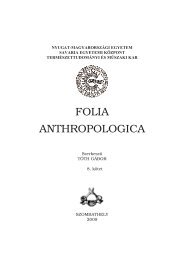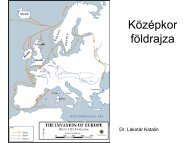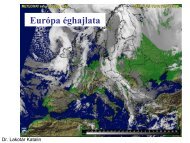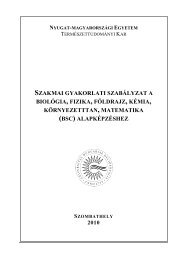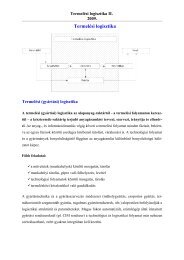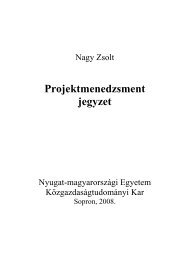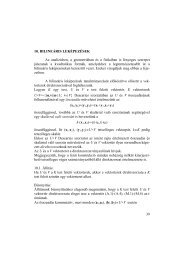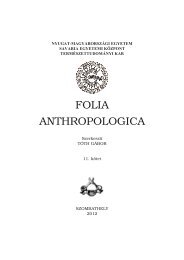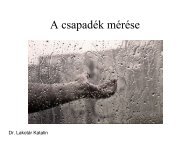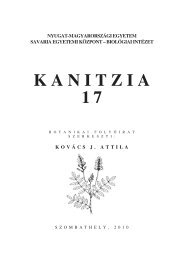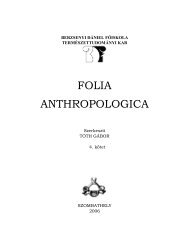Kanitzia 18. - NYME Természettudományi Kar - Nyugat ...
Kanitzia 18. - NYME Természettudományi Kar - Nyugat ...
Kanitzia 18. - NYME Természettudományi Kar - Nyugat ...
You also want an ePaper? Increase the reach of your titles
YUMPU automatically turns print PDFs into web optimized ePapers that Google loves.
K A N I T Z I A <strong>Kanitzia</strong> 18: 89–194., Szombathely, 2011<br />
Journal of Botany<br />
ADDENDA TO “FLORA ROMANIAE” VOLUMES 1-12.<br />
Newly published plants, nomenclature, taxonomy, chorology<br />
and commentaries (Part 1)<br />
GAVRIL NEGREAN<br />
775311-Bucureşti, Bd. I. Maniu 55, Romania; e-mail: negrean_gavril@yahoo.com<br />
Abstract<br />
Negrean G. (2011): Addenda to “Flora Romaniae” Volumes 1-12. Newly published plants,<br />
nomenclature, taxonomy, chorology and commentaries (Part 1). – <strong>Kanitzia</strong> 18: 89–194.<br />
“Flora României” was completed several years ago. Since the edition of this fundamental work numerous<br />
studies have been concluded and several new species have been published (see BORZA(1963),<br />
BORZA & NYÁRÁDY (1963), BELDIE & VÁCZY (1976), NEGREAN (1987), OPREA (2005), CIOCÂRLAN<br />
(2009) requiring the summation and addition of these new results to the original work. A lot of<br />
botanists, in our country and even from abroad, contributed to the enrichment of the Romanian flora.<br />
Some new taxa, reviewed in this work, are from the spontaneous flora, found in the zones not investigated<br />
before; others belong to the category of newly re-discovered taxa which were not referred to<br />
for a long period. Finally, the majority of these species probably belong to the alien category, many<br />
with invasive character and which threaten the spontaneous flora. In the 13 volumes of “Flora Romaniae”<br />
64 major taxa (species and subspecies) were published (BELDIE & VÁCZY 1976). Later, the<br />
number of published major taxa increased considerably, in our work cca 514 taxa have been listed.<br />
The list includes the taxa names, synonyms, family (abbreviated with three letters) (WEBER 1982),<br />
wide chorology, as well as commentaries where necessary. It summarizes the results of several<br />
decades of my scientific work started and inspired by my high school teacher, Paul Pteancu, the best<br />
assistant of Professor Borza. This work is concluded with an extensive bibliography including more<br />
than 900 paper and website references. As such an enrichment process – desired or not – would never<br />
end, thus we propose to continue to review and update this listing at regular time intervals. As in any<br />
work of this magnitude, it is possible that some omissions inherently exist, for which we do apologize.<br />
Key words: Romanian Flora, taxonomy, chorology, commentaries<br />
Introduction<br />
Romania is relatively rich in plants species. This is due to its global location, at middle<br />
distance between the Equator and the Pole, exactly in the geometrical centre of Europe,<br />
halfway between the chine of Ural mountains and the Finisterra Cape in the continental<br />
Europe, halfway of the influence of the Atlantic and the continental gradients; halfway between<br />
North Cape and Matapan Cape in Greece. As it is known, the mark designating the<br />
geometrical centre of Europe, is East of Sighetul Marmaţiei (Mármarossziget) on the Tisa<br />
river bank and was raised long ago by the Austrian topogra-phers. However, the existence<br />
of the mountains catena, representing the main endemogene zones in our country, considerably<br />
enriches the flora. The historical area of Dobrudja, with the oldest dry land in our<br />
country and even in Europe, is important from a phytogeografic point of view as well. Generally,<br />
in south, especially in “Porţile de Fier” area, as well as in Dobrudja, the Mediter-<br />
89




